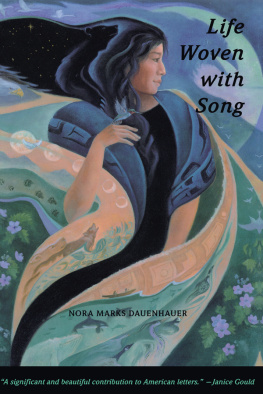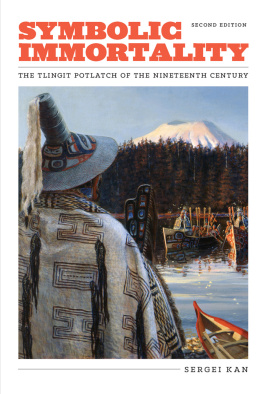POTLATCH
NATIVE CEREMONY AND MYTH ON
THE NORTHWEST COAST
MARY GIRAUDO BECK
ILLUSTRATED BY MARVIN OLIVER

To those who have
celebrated the potlatch
today and yesterday
Text 1993 by Mary Giraudo Beck
Illustrations 1993 by Marvin Oliver
All rights reserved. No part of this book may be reproduced or
transmitted in any form or by any means, electronic or mechanical, including photocopying, recording, or by any information storage and retrieval system, without written permission of the publisher.
Library of Congress Cataloging-in-Publication Data
Beck, Mary Giraudo, 1924
Potlatch: Native ceremony and myth on the Northwest Coast / by Mary Giraudo Beck; illustrations by Marvin Oliver.
p. cm.
Includes bibliographical references ().
ISBN 978-0-88240-820-0
1. Potlatch. 2. Indians of North AmericaNorthwest Coast of North AmericaRites and ceremonies. 3. Indians of North AmericaNorthwest Coast of North AmericaLegends. I. Title.
E78.N78B43 1993 | 92-47012 |
394.2'089'974dc20 | CIP |
Manuscript Editor: Lorna Price
Cover and Book Designer: Elizabeth Watson
Cover illustration: Section of Raven and Sun with Two Frogs, 1993, painted
wood sculpture 25 feet tall, Tokushima, Japan. Marvin Oliver.
Alaska Northwest Books
An imprint of Graphic Arts Books
P.O. Box 56118
Portland, OR 97238-6118
(503) 254-5591
www.graphicartsbooks.com
CONTENTS
ACKNOWLEDGMENTS
I would like to express appreciation to Gilbert McCleod, Bob Henning, and Ivy and Robert Peratrovich for providing information, and to Andrew Hope III for recommending sources.
I am grateful too to Dolly Jensen and Nancy and Jonathan DeWitt for reading the manuscript for authenticity and also supplying information.
My special thanks go to editors Ellen Wheat and Lorna Price for their invaluable suggestions on the text.
INTRODUCTION
Today totem pole raisings or memorial celebrations are the chief occasions for potlatches, when the people of the Pacific Northwest Coast Native communities gather to celebrate their culture. Songs, dances, and stories enacted in ceremonial regalia remind them of their history and beliefs. Preparations made beforehandcarving the totem, refurbishing ceremonial garments, practicing songs, dances, and storiesstir pride in their traditions and heritage.
For centuries Pacific Northwest Coast peoples from Alaska, Canada, Washington, and Oregon have held potlatches to honor the dead and sometimes also to celebrate births and marriages. These elaborate ceremonies employed complex symbolism and included singing, dancing, recitations of lineages and rights, distribution of gifts, and hosting a lavish feast. Invited guests witnessed these activities and thereby validated their hosts claims to names, rank, and property. But the claims of the guests to their own rank and prestige were enhanced through the honor accorded them in the position of their assigned seats and the value of the gifts they received, both being determined by the individuals wealth and status.
Athapaskans, Tlingit, Tsimshian, Haida, Kwakiutl, Bella Bella, Bella Coola, West Coast (Nootka), Salish, Makah, Quinault, Chinookall celebrated the potlatch, each with its own variations on the order or number of the basic elements of singing, dancing, recitations, gift-giving, and feasting, but always observing certain established procedures. Each group had its own name for this ceremonythe Salish Klanax, the Tlingit Xuix, or the Kwakiutl P!Esa. But in communicating with whites or with Natives who spoke a different language, they adopted the Chinook potlatch derived from the West Coast patshatl, or giving.
Todays potlatch, usually of one or two days duration, is a shortened form of a lavish ceremony that reached the peak of ostentatious luxury in the mid to late nineteenth century. The Natives wealth, which had increased through trade with Europeans at that time, enabled them to make greater expenditures on increasingly elaborate potlatches.
For Southeast Alaska Natives, honoring the dead was the main purpose of major potlatches and a vital part of any type of potlatch. The Tlingit especially were responsible for the formalization of the cremation and memorial potlatches in the early nineteenth century, and the more formal procedures were gradually adopted by other Pacific Northwest Coast groups. At midcentury this same form carried over to the prestige potlatch, a ceremony with the same basic elements as the funeral potlatch but with added features.
The first of the two potlatches held to honor the dead, the solemn smoking feast and cremation rites, or feeding of the dead, took place right after the death of a high-ranking person. About a year later a second funeral service, the memorial potlatch, was helda formal eight-day ceremony that served the added purpose of naming the successor chief. Those who could not afford to give the large memorial potlatch, however, could memorialize their recent dead at a major potlatch by donating a gift to it. But ever-increasing wealth gave rise to the prestige potlatch, whose main purpose was to raise the status of children. Only high-ranking, wealthy chiefs could afford to give these luxurious potlatches to further their childrens prospects of becoming chief of a house or even head chief of a clan. The less affluent, emulating them, sometimes impoverished themselves in the process.
To possess high status in Northwest Coast Native societies, in addition to being born in a powerful family and clan, one had also to observe social customs and be accomplished in seamanship, fishing, hunting, and waging war. People closely related to the chief had high status, while those more distantly related held middle rank. The very poor and freed slaves made up the lowest class. A chief was selected from the highest ranking nephews of the deceased chief, his sisters children who, in addition to the traits that earned them high rank, showed strength of character, an even temperament, and high regard for clan tradition.
Major potlatches frequently included some functions of minor onesdedicating a new house, raising a totem pole, or bestowal of a new name. A new house was built for an anniversary potlatch, and after its dedication the deceased chiefs successor would live there with his family. A mortuary pole was raised to memorialize the deceased chief, whose ashes were placed in a box on top or in a niche at the back of the pole. Other poles were raised for prestige purposes. All of them told stories belonging to the clan of the honored person. A pole could also be raised to ridicule someone who had failed to fulfill an agreement or pay a debt, and would depict the specific event. The small potlatches given for these purposes lasted a day or two and generally provided an opportunity to repay debts for services. A small potlatch for women celebrated the coming-out of a young girl who had gone into the customary three-month seclusion at the arrival of her first menses.
An important Pacific Northwest Coast ritual similar to the potlatch and often casually called by that name was the Deer Ceremony, given to solemnize peace treaties. Though this ritual, like a major potlatch, lasted eight days and ended with a feast, it did not include gift-giving or games, and the songs and dances were performed only by the hostages, or deerprominent people carefully selected from the two peace-seeking clans to enact the peace overtures.
A major potlatch, such as the memorial for a deceased chief, lasted eight days. Before the formal ritual of the potlatch, guests were entertained for four days at parties given by various houses of the host clan. The serious rituals of the potlatch then began, and everyone joined the host group in mourning the deceased chief, while the host chief sang mourning songs, repeated clan history and stories, and reiterated clan rights. At this time they also narrated the feats of the clever and wily Raven, a near-deity whom all clans revered for his many gifts to mankind. For it was Raven who had created human beings from lesser creatures and animals from inanimate objects, assigning all their respective roles, and who then gave them the unsurpassed benefits of light, fire, and water. The Tlingit credited their custom of gift-giving to Ravens example.













